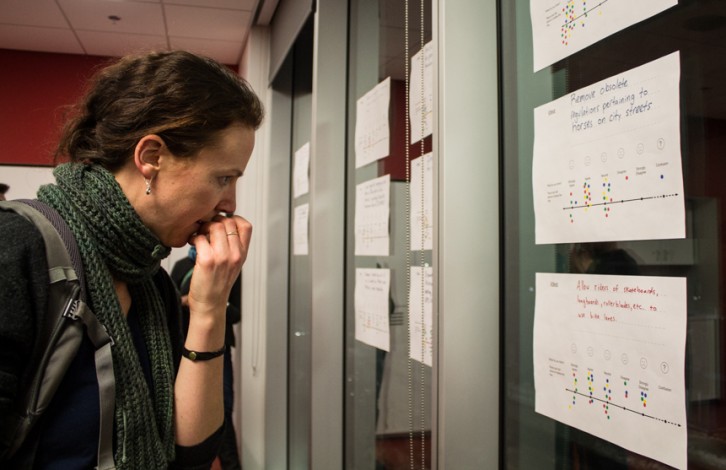Transportation
Cyclists want Motor Vehicle Act to include lower speed limits, new fines
Halifax roads ‘aren’t safe’ for active transportation users, cyclists say

caption
Brendan Piper says Halifax is designed primarily for cars.
caption
Brendan Piper says Halifax is designed primarily for cars.Members of the community indicated their support last night for changes to the Nova Scotia Motor Vehicle Act such as allowing municipalities to post speed limits below 50 km/h and penalizing aggressive driving.
The proposed changes were introduced by the Halifax Cycling Coalition in partnership with It’s More Than Buses, Walk ‘n’ Roll Halifax, Bicycle Nova Scotia and others.
“The act was drafted close to 100 years ago and doesn’t acknowledge new types of infrastructure and new types of vehicles,” said Chris Donahoe, one of two project leaders.
“Halifax’s roads aren’t as safe as they could be for people using alternate modes of transportation than cars. I’m a cyclist and I don’t feel safe most of the time,” he said.
The first public consultation took place at the Halifax Public Library. People were invited to drop-in throughout the evening to read proposal sheets and provide feedback. They were given stickers upon arrival, and were invited to stick them to different parts of the sheets corresponding to how strongly they agreed or disagreed with each proposal.
Donahoe is leading the project with Paul Calderhead, a board member with the Halifax Cycling Coalition.

caption
Chris Donahoe and Paul Calderhead started researching the project last summer.“Dooring” is a major issue Calderhead and Donahoe identified. Those in attendance were strongly in favour of imposing a law to prevent it. Dooring occurs when a car door is opened suddenly into a bike lane or into traffic. The Halifax Cycling Coalition says it wants a law introduced against opening doors into the path of any vehicle with a minimum fine of $1,000. Another popular issue is right turns at intersections.
“Cars pass cyclists too close to an intersection and then turn, cutting cyclists off. Motorists don’t realize the rate of speed cyclists go, and then the cyclist ends up t-boning the car when it turns,” said Donahoe.
Changing the name of the act was also a recommendation many felt was important. They hope the name of the act will be changed to something more inclusive such as the Road Safety Act or Traffic Safety Act.
Researching models
The Halifax Cycling Coalition advocates on behalf of cyclists to improve safety, infrastructure and facilities. There are currently 250 members. The coalition is hoping to get feedback from everyone on the proposed changes – not just cyclists.
“Motorists have voiced their concerns and it’s good to hear different angles on things I previously approached as a cyclist or pedestrian issue,” said Calderhead.
Calderhead and Donahoe cite other jurisdictions such as Washington state, Seattle, New York City and Edmonton as having good road safety legislation.
While the coalition was researching road safety models in other cities, the province enacted changes to pedestrian fines. Although they were originally planning to do consultation in the spring, Calderhead and Donahoe decided to speed up the process and get feedback from the public on changes the coalition is proposing.
“Pedestrian advocacy groups want to see a revisiting of the fines put in place on pedestrians in crosswalks. We want to see some revisions there too,” said Donahoe. One of the proposals asked for a thorough review of all penalty and fine structures under the Motor Vehicle Act.
Miscommunication
Sarah Mitchell came to the event because she is a cyclist and rides her bike from Halifax to Burnside every day for work.
“I get yelled at a lot by people who think I’m doing something wrong. There’s a lot of miscommunication around the rules of the road,” said Mitchell.
There have been times she’s waiting to cross an intersection and a car will wave her across.
“That shouldn’t be allowed. While I’m on my bike, I’m a vehicle as well,” said Mitchell. “One car might wave me across but since it’s not legal, other cars might not stop while I’m crossing.”

caption
Sarah Mitchell strongly agreed with the proposals about fines for aggressive driving, and making bike lanes wider on high speed roads.She’s glad the Halifax Cycling Coalition is doing these consultations.
“It affects everyone, so everyone should have a voice,” said Mitchell.
Joachim Stroink, MLA for Halifax-Chebucto, was also at the event. He said most people in Halifax use the roads on a daily basis.
“I live in the HRM so I walk or skateboard to work,” said Stroink. “We need to be having a discussion about all forms of active transportation.”
The Halifax Cycling Coalition and partners will be meeting with the deputy minister of transportation in February about the changes they are proposing. They hope the province will implement the less contentious changes by the fall.


J
Jimmy
j
jackie
S
Sam Austin